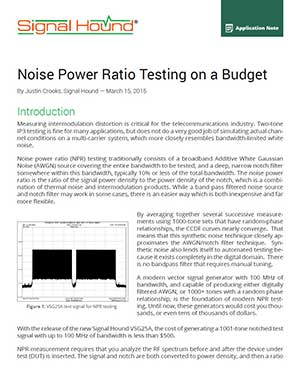We just posted a new application note titled “Noise Power Ratio Testing on a Budget” that details NPR testing with our VSG25A vector signal generator. Justin (our head engineer) wrote the app note, and it includes a step-by-step procedure for testing NPR with the VSG25A and our BB60C 9 kHz to 6 GHz spectrum analyzer, although you can technically use any spectrum analyzer for this process.
Here’s an excerpt from the app note:
“Measuring intermodulation distortion is critical for the telecommunications industry. Two-tone IP3 testing is fine for many applications, but does not do a very good job of simulating actual channel conditions on a multi-carrier system, which more closely resembles bandwidth-limited white noise.
Noise power ratio (NPR) testing traditionally consists of a broadband Additive White Gaussian Noise (AWGN) source covering the entire bandwidth to be tested, and a deep, narrow notch filter somewhere within this bandwidth, typically 10% or less of the total bandwidth. The noise power ratio is the ratio of the signal power density to the power density of the notch, which is a combination of thermal noise and intermodulation products. While a band pass filtered noise source and notch filter may work in some cases, there is an easier way which is both inexpensive and far more flexible.“
If NPR testing is something you do or your company does, this is worth a read. Signal Hound devices are designed to economically replace larger, more expensive equipment (which may be overkill for the task at hand), and perform to exceptionally high standards.
